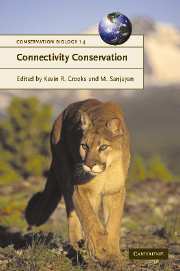Book contents
- Frontmatter
- Contents
- List of contributors
- Acknowledgements
- 1 Connectivity conservation: maintaining connections for nature
- PART I Approaches to connectivity research
- Introduction: Connectivity research—what are the issues?
- 2 Landscape connectivity: a return to the basics
- 3 Connectivity and metapopulation dynamics in highly fragmented landscapes
- 4 Genetics and landscape connectivity
- 5 Connectivity at the land–water interface
- 6 Influence of natural landscape fragmentation and resource availability on distribution and connectivity of gray wolves (Canis lupus) in the archipelago of coastal British Columbia, Canada
- 7 Migratory connectivity
- 8 Connectivity in marine ecosystems: the importance of larval and spore dispersal
- 9 Connectivity and wide-ranging species in the ocean
- 10 Hydrologic connectivity: a neglected dimension of conservation biology
- 11 Connectivity and ecosystem services: crop pollination in agricultural landscapes
- PART II Assessing connectivity
- PART III Challenges and implementation of connectivity conservation
- Index
- References
6 - Influence of natural landscape fragmentation and resource availability on distribution and connectivity of gray wolves (Canis lupus) in the archipelago of coastal British Columbia, Canada
Published online by Cambridge University Press: 24 May 2010
- Frontmatter
- Contents
- List of contributors
- Acknowledgements
- 1 Connectivity conservation: maintaining connections for nature
- PART I Approaches to connectivity research
- Introduction: Connectivity research—what are the issues?
- 2 Landscape connectivity: a return to the basics
- 3 Connectivity and metapopulation dynamics in highly fragmented landscapes
- 4 Genetics and landscape connectivity
- 5 Connectivity at the land–water interface
- 6 Influence of natural landscape fragmentation and resource availability on distribution and connectivity of gray wolves (Canis lupus) in the archipelago of coastal British Columbia, Canada
- 7 Migratory connectivity
- 8 Connectivity in marine ecosystems: the importance of larval and spore dispersal
- 9 Connectivity and wide-ranging species in the ocean
- 10 Hydrologic connectivity: a neglected dimension of conservation biology
- 11 Connectivity and ecosystem services: crop pollination in agricultural landscapes
- PART II Assessing connectivity
- PART III Challenges and implementation of connectivity conservation
- Index
- References
Summary
INTRODUCTION
Connectivity has emerged as an important ecological concept relating to how animals move among habitat patches in fragmented environments. Although connectivity is often considered landscape- and species-specific (Tischendorf and Fahrig 2000; Taylor et al. Chapter 2), fundamental ecological and physical processes influence movements of all species. Taylor et al. (1993) define connectivity as “the degree to which the landscape facilitates or impedes movement among resource patches.” Most research, however, has centered on impediments to movement. For example, Tischendorf and Fahrig (2000) argue that landscape connectivity is “essentially equivalent to the inverse of patch isolation over the landscape.” Herein we examine landscape and resource features that not only potentially impede (i.e., isolation) but also might facilitate (i.e., availability of food) movement of wolves (Canis lupus) using coastal islands in British Columbia, Canada.
Investigations of oceanic archipelagos have revealed how island communities and species composition are related to area, isolation, and other island characteristics (e.g., MacArthur and Wilson 1967; Abbott 1974; Kadmon and Pulliam 1993; Conroy et al. 1999). Biogeographic features, however, may also exert influence at the population level, including the mediation of predator–prey dynamics on islands or in other fragmented systems (Kareiva 1990; Kareiva and Wennergren 1995; Dolman and Sutherland 1997; Darimont et al. 2004). The equilibrium theory of island biogeography (MacArthur and Wilson 1967) and metapopulation theory (Levins 1976; Gilpin and Hanski 1991; Hanski and Gilpin 1996; Moilanen and Hanski Chapter 3) postulated several abiotic mechanisms explaining animal distribution and population persistence in patchy landscapes.
- Type
- Chapter
- Information
- Connectivity Conservation , pp. 130 - 156Publisher: Cambridge University PressPrint publication year: 2006
References
- 12
- Cited by

